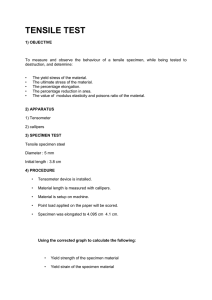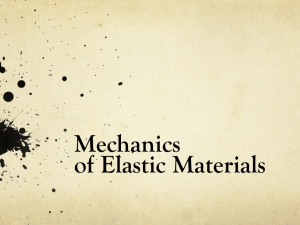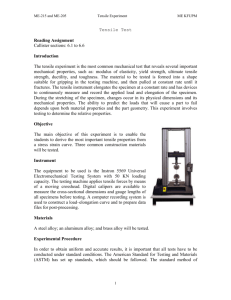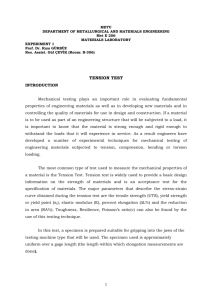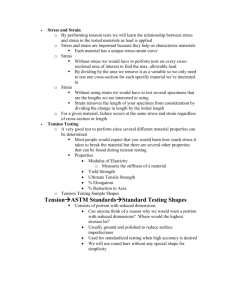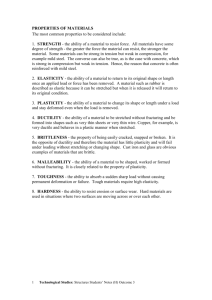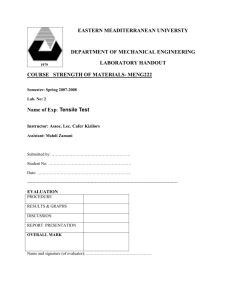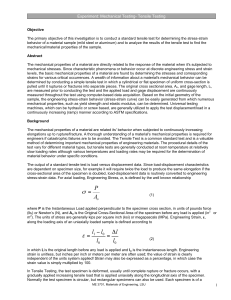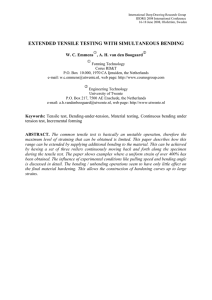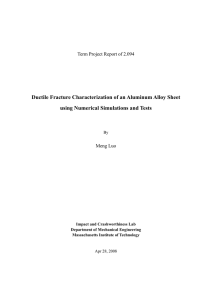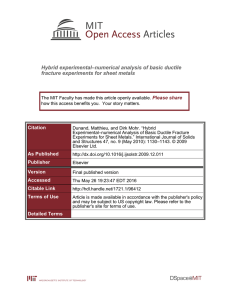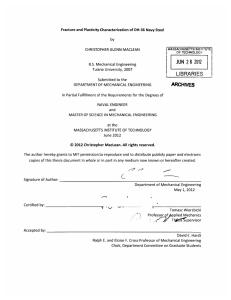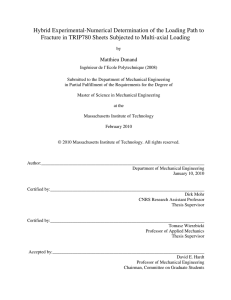8.Tensile Testing 3451
advertisement
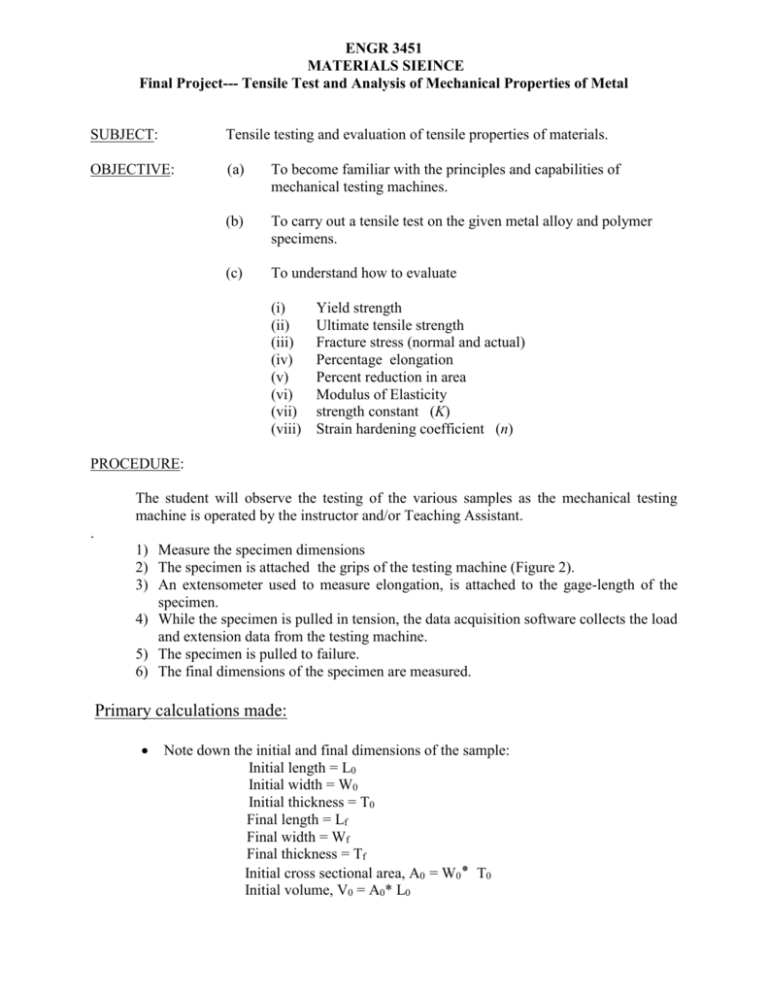
ENGR 3451 MATERIALS SIEINCE Final Project--- Tensile Test and Analysis of Mechanical Properties of Metal SUBJECT: Tensile testing and evaluation of tensile properties of materials. OBJECTIVE: (a) To become familiar with the principles and capabilities of mechanical testing machines. (b) To carry out a tensile test on the given metal alloy and polymer specimens. (c) To understand how to evaluate (i) (ii) (iii) (iv) (v) (vi) (vii) (viii) Yield strength Ultimate tensile strength Fracture stress (normal and actual) Percentage elongation Percent reduction in area Modulus of Elasticity strength constant (K) Strain hardening coefficient (n) PROCEDURE: The student will observe the testing of the various samples as the mechanical testing machine is operated by the instructor and/or Teaching Assistant. . 1) Measure the specimen dimensions 2) The specimen is attached the grips of the testing machine (Figure 2). 3) An extensometer used to measure elongation, is attached to the gage-length of the specimen. 4) While the specimen is pulled in tension, the data acquisition software collects the load and extension data from the testing machine. 5) The specimen is pulled to failure. 6) The final dimensions of the specimen are measured. Primary calculations made: Note down the initial and final dimensions of the sample: Initial length = L0 Initial width = W0 Initial thickness = T0 Final length = Lf Final width = Wf Final thickness = Tf Initial cross sectional area, A0 = W0 ٭T0 Initial volume, V0 = A0* L0 Data obtained from the test: Time Elongation Load Tensile strength Tensile strain ASSIGNMENT: Assignments: Testing Procedure: 1. Record the initial data Operator: ____________________________ Group number: ________________________ Group members: ____________________________ Date: _______________________________ Specimen 1: _________________________ Notes: ______________________________________________________________________________ Prep work Diameter measurements with caliper or micrometer (take 3, report the average): __________ __________ __________ in. Average diameter = __________ in., initial cross section area = __________ in2. Mark a 2 in. gauge length on your specimen with marker and caliper. L0 = 2 in. 2. Record the direct results from the test. Elastic Modulus = _____________________________________________ Ultimate stress = ______________________________________________ 1. Define engineering stress, engineering strain, true stress, and true strain. 2. Check out the cross-sectional area of the test section. Is it your standard ASTM tensile specimen? Check the width and thickness at three different places for the appropriate cross-section dimensions. 3. Discuss the difference between elastic and plastic deformation. 4. Make a copy of the data files from the data acquisition software onto a memory stick. 5. On your engineering stress strain curves (see ‘Results’), discuss and indicate elastic limit, upper yield point, lower yield point, ultimate stress, proportional limit, and fracture stress. Discuss what kind of properties would be observed if the material had a brittle fracture. RESULTS: 6. Discuss the classical ‘cup and cone’ fracture (ductile fracture) and type of fracture of cast irons. 7. List any possible sources of error in your testing and evaluation of engineering stress-strain curve. Use a spreadsheet program (Microsoft Excel, etc.) to calculate and plot true stressstrain curves from the loadextension data collected from the data acquisition software. Afterwards, calculate: (i) Modulus of Elasticity, E, from the elastic region of stressstrain curves. (ii) 0.2% offset yield strength. (iii) Fracture strength. (normal and actual) (iv) % Elongation at Fracture = (v) % Reduction of area = L f Lo Lo Ao A f Ao 100 100 (vi) Value of the strength constant, K, and the strain hardening coefficient, n, in the plastic region using: T K Tn Actual strain = Elongation / gage length (gage length = 1 inch) E = ∆L / L0 Actual Area = Vi / (Li + Elongation) Nominal stress = Load / A0 Nominal strain = Elongation / L0 True stress = Load / Actual area = F/A0 4. Draw a graph between Nominal stress (y-axis) and Nominal strain (x-axis); Log (True stress) (y-axis) and Log (True strain) (x-axis) , from which the following can be calculated. Sample graphs are shown below: Note: Actual stress and true stress are the same; actual strain and true strain are the same. A picture of Instron® universal testing machine in the Laboratory. More information about the tensile testing machines could be found from the references at the end of the guideline. Typical tensile specimen References: 1. Your course textbook, Chapters 7 and 9.8 2. Annual Book of ASTM Standards, Vol. 03.01, Metals Tests methods and procedures, designation E8, 1995 (or the recent edition) It should be available in the Research Park Reference Library. 3. ASM Handbook, Mechanical Testing, Vol. 8, ASM-Intl., Materials Park, Ohio (available in the Research Park Reference Library. http://www.instron.us/wa/products/universal_material/5500.aspx Good luck
